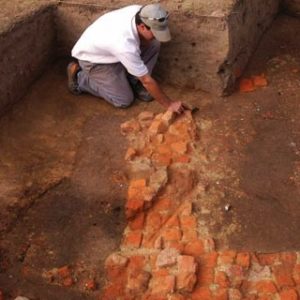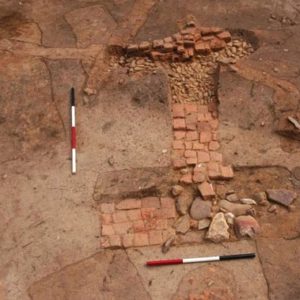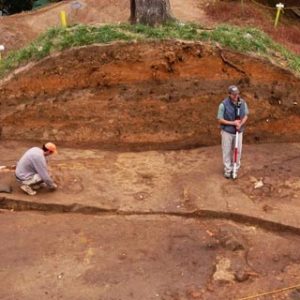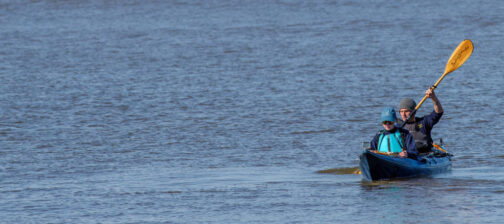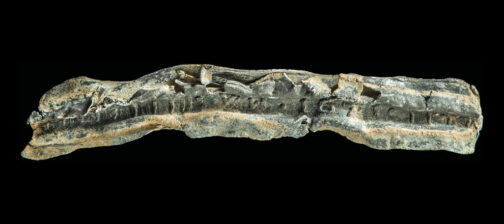As the weather begins to warm up, archaeologists are working outside more regularly now. Currently, they are excavating inside the west wall of the James Fort site in the same area where they were working last fall. Here’s an update on what they discovered during the winter and what’s happening now.
Archaeologists recently finished digging through a mound of dirt that was about six feet deep near the center of a long cobblestone building foundation. Just as they thought when they started working on the feature last November, the mound covered a bomb shelter inside the Confederate Fort area that was used by soldiers during the Civil War.
Archaeologist Danny Schmidt said that over time, the shelter, which was about 12 feet wide and at least 18 feet long, collapsed in on itself. A U-shaped layer of orange soil can still be seen in the profile of the dirt mound and provides proof of the collapse. A deposit of grayish soil inside the orange layer shows that the depression was filled in later.
Archaeologists also found fragments of wood along the edge of the room from the ceiling, and there is evidence that there were air shafts on each side about 6′ long. Schmidt said the location of nails and stains discovered in the remains of the shafts indicate that the duct was a wooden box about 8-10″ wide, made by nailing the sides to the bottom and top.
No Civil War artifacts have been found at the site, yet. Archaeologists don’t expect to find artifacts from that time period until they dig deeper into the feature and get to the floor level. Schmidt said the bomb shelter probably cut through and destroyed the 17th-century level of soil below it, so they do not plan to excavate any more of this feature for a while. Instead, since excavating the 17th-century level of the site is a priority, they will continue to focus on uncovering and excavating the fort period features.
More surprising information came from Structure 172, the long cobblestone foundation of an early 1700s building that they discovered last fall. Until recently, archaeologists thought this building was about 167′ long and 20′ wide, similar in form to a London rowhouse or almshouse. A few weeks ago, they found builders trenches near the middle of the foundation that show that there were actually two buildings, instead of one, according to Jamie May, senior archaeologist. The most western building is about 88′ x 20′. The other building near the north corner of the fort site is about 64′ x 20′.
The foundations to both buildings are about 10 feet away from and parallel to the west wall of the James Fort site, which is the same as other early structures that have been unearthed inside the fort site. This indicates that they were probably built sometime between 1607 and 1622, when the fort was in use.
Last season, archaeologists uncovered three H-shaped hearths inside the larger building, which divide it into about six rooms. May said one H-shaped hearth has been uncovered in the other building, and it may have had at least one more hearth, but the archaeological evidence no longer exists. If so, then it would have had four rooms.
They also uncovered the remains of floor joists and nails in the end room of the building near the north corner of the fort site and brick foundations of what appears to be an addition. According to William Kelso, APVA director of archaeology, it’s possible that this was the governor’s house. Based on what they know so far about the building and a written reference that was discovered by Bly Straube, APVA curator, Kelso said it may be the house that was built in 1611 for Thomas Gates when he was governor.
According to a reference in the Virginia Company Records, written in November 1618, future governors enlarged and continued to use Gate’s house as their residence:
“And we do hereby ordain that the Governors house in James town first built by Sir Thomas Gates Knight at the charges and by the Servants of the Company and since enlarged by others by the very same means be and continue forever as the Governors house…”
At the larger cobblestone building near the western corner of the fort, May said numerous post holes between the cobblestone foundation and the wall of the fort appear to indicate that an earth fast building was there first. There are also a couple of rectangular pits and two circular pits in the same area.
Bermuda limestone that was used in the construction of one of the hearths also helps date the building. The earliest date that Bermuda limestone could have been in the colony is the spring of 1610 when colonists who had been shipwrecked for a year in Bermuda, finally arrived at Jamestown. Bermuda limestone was proclaimed by the colonists to be very good ballast, and they may have used it in the new ship they built to reach Jamestown. May said this tells them that the building could have been constructed no earlier than the spring of 1610.
In addition, the larger cobblestone building was built over two double graves that each contained two males who were buried at the same time in English-style burials. Their heads were placed in the northwest end of the grave shaft, and two of the burials were shrouded. May said it’s possible that the other two were also shrouded, but it wasn’t clear from the archaeological evidence. A couple of aglets were found in one of the graves, but there were no other artifacts. The graves were perpendicular to the wall of the fort, and one was disturbed by construction of the hearth with the limestone, so they are earlier than 1610. Kelso said there’s no doubt that the individuals were among the early settlers. The remains are being studied by the Smithsonian Institution.
Artifacts discovered above and around the buildings seem to include a relatively high concentration of status items compared to other areas of the fort site such as broken Chinese porcelain wine cups, ceramics and glassware in the facon de Venise. Archaeologists have also discovered the lens of an early telescope, a 1605 Bartmann jug medallion, and pieces of delftware wall tiles, probably from the second quarter of the 17th century. Personal objects such as a small silver wax seal with a scallop shell design, a silver putto, a crucifix made of jet, the cap of the handle of a small silver knife engraved with the initials FP and the date 1622, and other items such as buttons, aglets, oyster shells and food remains have also been found in this area.
Straube said these artifacts were mixed up in the soil that was deposited above the building site during the construction of the Civil War fort and cannot be used to date the building, but they may indicate that this end of the fort was where high-ranking colonists lived.
related images
- Far eastern hearth of the cobblestone building with plow scars
- Eastern end of cobblestone building with floor joists and brick addition
- Far western hearth of the cobblestone building built over burials
- Profile of the Civil War bomb shelter



